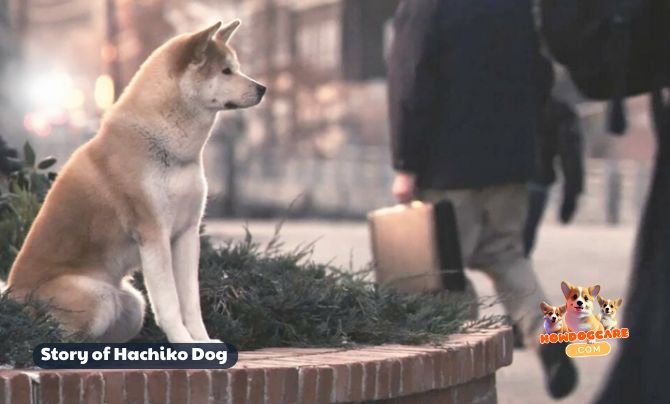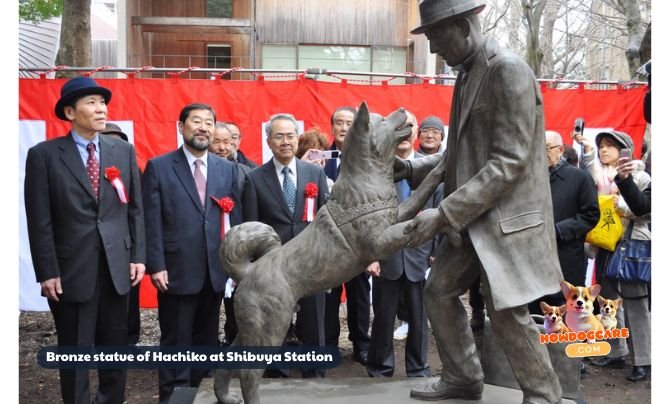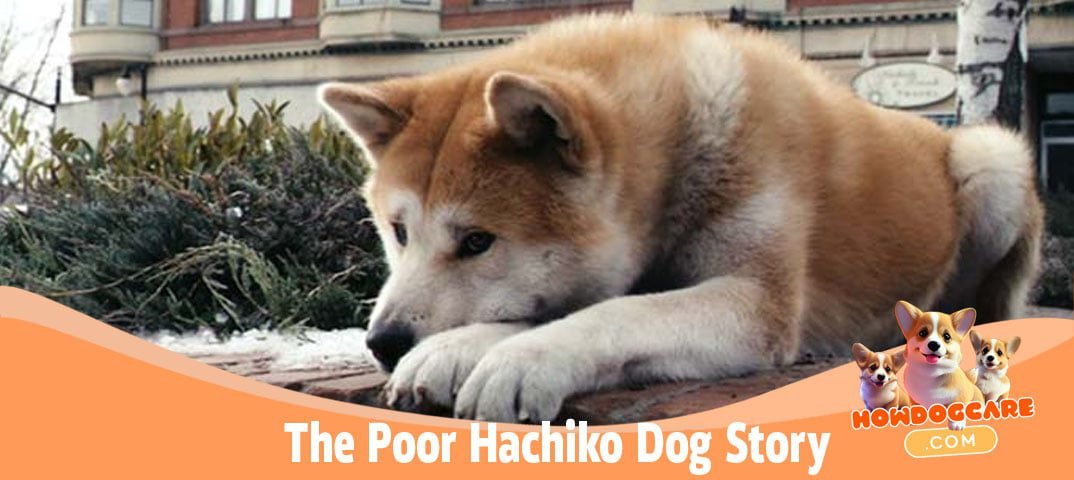Learn Why the Hachiko Dog Is Celebrated Worldwide for His Unmatched Devotion
The story of the Hachiko Dog is one of the most famous and heart-touching dog stories in the world. Hachiko’s loyalty transcended time and tragedy, and his tale continues to inspire millions as a shining example of pure love, patience, and unwavering loyalty. Below, we explore the real-life story of Hachiko, why he became a national treasure in Japan, and how his legacy lives on.
Who Was Hachiko Dog?

The Beginning of Hachiko’s Journey in Japan
Hachiko was a small, white Akita breed dog, born in November 1923 in Akita Prefecture, Japan. As a puppy, he was adopted by Professor Ueno Eizaburo, a professor at Tokyo University. Without children of his own, Professor Ueno treated Hachiko as part of his family—almost like his own child.
Every morning, Hachiko accompanied his owner to Shibuya Station where Ueno boarded the train for work. At 3:00 PM sharp every afternoon, Hachiko faithfully returned to the station to greet his beloved master and walk him home. This daily routine became a touching ritual for the pair.
The Day Everything Changed for Hachiko Dog
Professor Ueno’s Sudden Death and Hachiko’s Endless Waiting
On May 12, 1925, tragedy struck. While at work, Professor Ueno suffered a sudden stroke and passed away. That day, he never returned home—and yet Hachiko did not know this. At 3:00 PM as always, Hachiko returned to Shibuya Station, patiently waiting for his master’s return. Hours passed, trains came and went, night fell—but the professor never appeared.
Despite this, Hachiko came back to the station every single day at the same time, faithfully hoping for his owner to return. He did this for nearly 10 years.
(*) Top 10 Best Electric Dog Nail Trimmer Reviews and Buying Guide
(**) Dog Travel Water Bottle Review: Top 10 Best Options For Hydration
The Community Embraced Hachiko Dog’s Loyalty
How Hachiko Became a Symbol of Faithful Love in Japan
Locals quickly took notice of the loyal dog’s heartbreaking vigil. Station workers, shop owners, and commuters began to feed and care for Hachiko, who seemed to sense something tragic but refused to give up hope. Hachiko’s dedication became a local legend, and people from all over began visiting Shibuya Station just to witness his devotion.
In 1932, a former student of Professor Ueno wrote an article about Hachiko’s unwavering loyalty, which was published in a major Tokyo newspaper. The story touched hearts across Japan and soon, Hachiko became a national icon, symbolizing loyalty, patience, and unconditional love.
Hachiko Dog’s Final Days and Passing
Hachiko’s Legacy of Loyalty Until His Last Breath
As years went by, Hachiko grew old. He developed arthritis and suffered from other ailments due to his age, yet his loyalty never wavered. He continued his daily pilgrimage to the station, even when his body grew weak.
On March 8, 1935, almost 11 years after Professor Ueno’s death, Hachiko was found dead on the very spot where he had waited all those years. He was 12 years old.
Hachiko’s death was announced on the front pages of newspapers across Japan. A nation mourned the passing of a dog whose simple yet profound loyalty had moved hearts worldwide.
The Memorialization of Hachiko Dog

Hachiko’s Statue at Shibuya Station: A Tribute to Loyalty
Thanks to public donations, a bronze statue of Hachiko was commissioned and sculpted by Ando Teru. It was unveiled at Shibuya Station, precisely where Hachiko had waited so faithfully. Despite World War II when most metal statues were melted down for the war effort, Hachiko’s statue survived.
In 1948, the statue was recast by Ando Teru’s son, Takeshi, and it stands to this day as a popular meeting point in Tokyo. Beside Professor Ueno’s grave at Aoyama Cemetery, there’s also a smaller statue of Hachiko honoring their everlasting bond.
Where Is Hachiko Now?
- Hachiko’s skeleton is preserved at the National Museum of Nature and Science in Tokyo.
- His heart rests eternally at Shibuya Station, where his statue continues to inspire visitors.
Hachiko Dog’s Impact on Japanese Culture and the World
How Hachiko Changed the World’s Perception of Dogs
Hachiko’s unwavering devotion has deeply impacted Japanese culture and the global perception of a dog’s loyalty. In Japan, the word “chūken” (忠犬) was popularized through Hachiko’s story, meaning “faithful dog.” His tale has been told in books, films, and even taught to school children as a lesson in loyalty and love.
Hachiko’s Story in Pop Culture:
- Books: Countless children’s books and novels.
- Movies: The 2009 Hollywood film “Hachi: A Dog’s Tale” starring Richard Gere brought Hachiko’s story to international audiences.
- Annual Memorial: Every year on March 8th, a ceremony is held at Shibuya Station to honor Hachiko’s memory.
(a) Top 10 Best Biodegradable Dog Poop Bags Reviews
(b) 10 Best Pumpless Water Dispenser for Cats & Small Dogs Reviews
Debunking the Barbecue Rumor About Hachiko Dog
Did Hachiko Really Stay for Free Food?
Some skeptics suggested that Hachiko’s daily visits were motivated not only by loyalty but also by the presence of a yakitori (grilled chicken skewer) restaurant nearby. While Hachiko was indeed clever and enjoyed occasional treats, his loyalty to Professor Ueno remains undeniable, as he continued his visits long after people stopped offering food.
The Emotional Lessons from Hachiko Dog’s Story
Why Hachiko’s Story Resonates Through Generations
Many people, especially those who grew up in the 80s and 90s, remember hearing Hachiko’s story as children—often bringing tears and a new appreciation for the bond between humans and animals. Hachiko teaches us that dogs are not “just pets.” They feel love, loss, and loyalty as deeply as we do.
This story is a reminder to cherish our animal companions, recognizing their deep emotional capacity and treating them as true members of our families.
Final Thoughts on the Hachiko Dog’s Story
The story of Hachiko Dog remains a timeless symbol of loyalty and love. His dedication is not just a heartwarming tale but a lesson in faithfulness, patience, and devotion that transcends cultures and generations. Whether you’re meeting a friend at Hachiko’s statue in Shibuya or watching “Hachi: A Dog’s Tale” with tissues in hand, Hachiko’s story continues to remind us of the extraordinary bond between humans and dogs.
FAQs About Hachiko Dog’s Story
What breed was Hachiko?
Hachiko was an Akita Inu, a breed known for its loyalty and strength.
Where is Hachiko’s statue located?
Hachiko’s famous bronze statue is at Shibuya Station in Tokyo, Japan.
Is Hachiko’s story true?
Yes, Hachiko’s story is a real historical account from 1925 to 1935 in Japan.
How did Hachiko die?
Hachiko died of natural causes at the age of 12, after faithfully waiting at Shibuya Station for nearly 10 years.
Why is Hachiko so important in Japan?
Hachiko symbolizes unwavering loyalty, devotion, and love, values deeply respected in Japanese culture.






